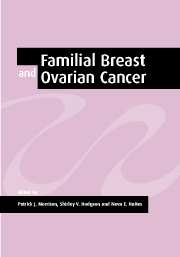Book contents
- Frontmatter
- Contents
- List of contributors
- Foreword by Helena Kennedy
- Preface
- Acknowledgements
- Part 1 Molecular biology and natural history
- Part 2 Screening
- 9 Developing a cancer genetics service: a Welsh model
- 10 Referral criteria for cancer genetics clinics
- 11 Guidelines for the development of cancer genetics services
- 12 Cultural and educational aspects influencing the development of cancer genetics services in different European countries
- 13 Screening, detection and survival patterns of breast and other cancers in high-risk families
- 14 Screening for familial ovarian cancer
- Part 3 Management
- Index
10 - Referral criteria for cancer genetics clinics
Published online by Cambridge University Press: 24 August 2009
- Frontmatter
- Contents
- List of contributors
- Foreword by Helena Kennedy
- Preface
- Acknowledgements
- Part 1 Molecular biology and natural history
- Part 2 Screening
- 9 Developing a cancer genetics service: a Welsh model
- 10 Referral criteria for cancer genetics clinics
- 11 Guidelines for the development of cancer genetics services
- 12 Cultural and educational aspects influencing the development of cancer genetics services in different European countries
- 13 Screening, detection and survival patterns of breast and other cancers in high-risk families
- 14 Screening for familial ovarian cancer
- Part 3 Management
- Index
Summary
Introduction
Setting criteria for referral to a clinic requires a clear view of the purpose of the clinic for which the criteria are being set. This chapter will review the current approaches to assessing and managing breast cancer risk and will attempt to put these approaches into the context of the available evidence regarding clinical effectiveness.
Background
Primary care and breast cancer units have found themselves besieged by women who are worried about their risk of breast cancer. The origins of this worry may be media driven, family driven or physician driven and may be appropriate (in those at high genetic risk) or inappropriate. In response to public demand for risk management options, many ‘family history’ clinics have sprung up throughout western Europe, offering breast screening to women who present with concerns about breast cancer risk, usually in this circumstance based on a family history of the disease. Breast screening mammograms with or without physical examination are the measures usually aimed at early breast cancer detection. There are no large scale randomized trials of breast screening in women who are under 50 years of age and at increased genetic risk of breast cancer. There are a small number of reported cohort studies involving relatively small numbers that indicate that breast cancer can be successfully detected at early stages in women under 50 who undergo regular screening examinations (Kollias et al., 1998; Lalloo et al., 1998; Møller et al., 1998; Kerlikowske et al., 2000; Tilanus-Linthorst et al., 2000).
- Type
- Chapter
- Information
- Familial Breast and Ovarian CancerGenetics, Screening and Management, pp. 157 - 165Publisher: Cambridge University PressPrint publication year: 2002



